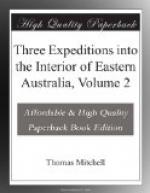September 18.
This day was passed in making preparations for setting out tomorrow with the light party as proposed.
SPECIMENS OF NATURAL HISTORY.
The catalogue of the objects of Natural History collected during the journey included several birds and animals not hitherto mentioned in this Journal. Amongst the most remarkable of these was the pig-footed animal found on June 16. It measured about ten inches in length, had no tail, and the forefeet resembled those of a pig. There was also the rat which climbs trees like the opossum; the flat-tailed rat from the scrubs of the Darling, where it builds an enormous nest of branches and boughs, so interlaced as to be proof against any attacks of the native dog. The unique specimen from the reedy country on the Murray of a very singular animal much resembling the jerboa or desert rat of Persia; also a rat-eared bat from the Lachlan. We had several new birds, but the most admired of our ornithological discoveries was a white-winged superb warbler from the junction of the Darling and the Murray, all the plumage not white being of a bright blue colour; but of this we had obtained only one specimen. I had not many opportunities of figuring the birds from life, so very desirable in ornithological subjects. The eye of the eagle and the rich crest of the cockatoo of the desert could not be preserved in dead specimens, and were too fine to be omitted among the sketches I endeavoured to snatch from nature.* Our herbarium had suffered from the continued wet weather, especially in fording deep rivers; and this was the more to be regretted as it contained many remarkable specimens. The seeds and bulbous roots comprising varieties of Calostemma, Caladenia, and Anguillaria, besides a number of large liliaceous bulbs, were however preserved in a very good state.**
(Footnote. See Plates 23 and 36.)
(**Footnote. The specimens of natural history were deposited in the Museum at Sydney, according to my letter of instructions. The seeds, amounting to 134 varieties, have been brought home and distributed, with the obliging assistance of my friend Dr. Lindley, amongst the principal gardens in this country. The bulbs, 62 in number, were planted soon after my arrival in England, in the gardens of the Horticultural Society at Chiswick. It was not without regret that I left at Sydney the single specimens of the Chaeropus and Dipus, but I took drawings representing each, of the natural size, and from these the figures in Plates 37 and 38 have been very accurately reduced by Mr. Picken.)
SITUATION OF DEPOT CAMP AT LAKE REPOSE.
The camp in which Mr. Stapylton’s party was to remain two weeks was in as favourable a place for refreshing the cattle as could be found. The ground undulated and was thickly clothed with fresh verdure; a grassy swamp also, such as cattle delight in, extended northward into a lake of fresh water which I named Lake Repose. The peaks of the Serra Range and especially Mount Abrupt were landmarks which secured the men from even the possibility of losing their way in looking after the cattle.




